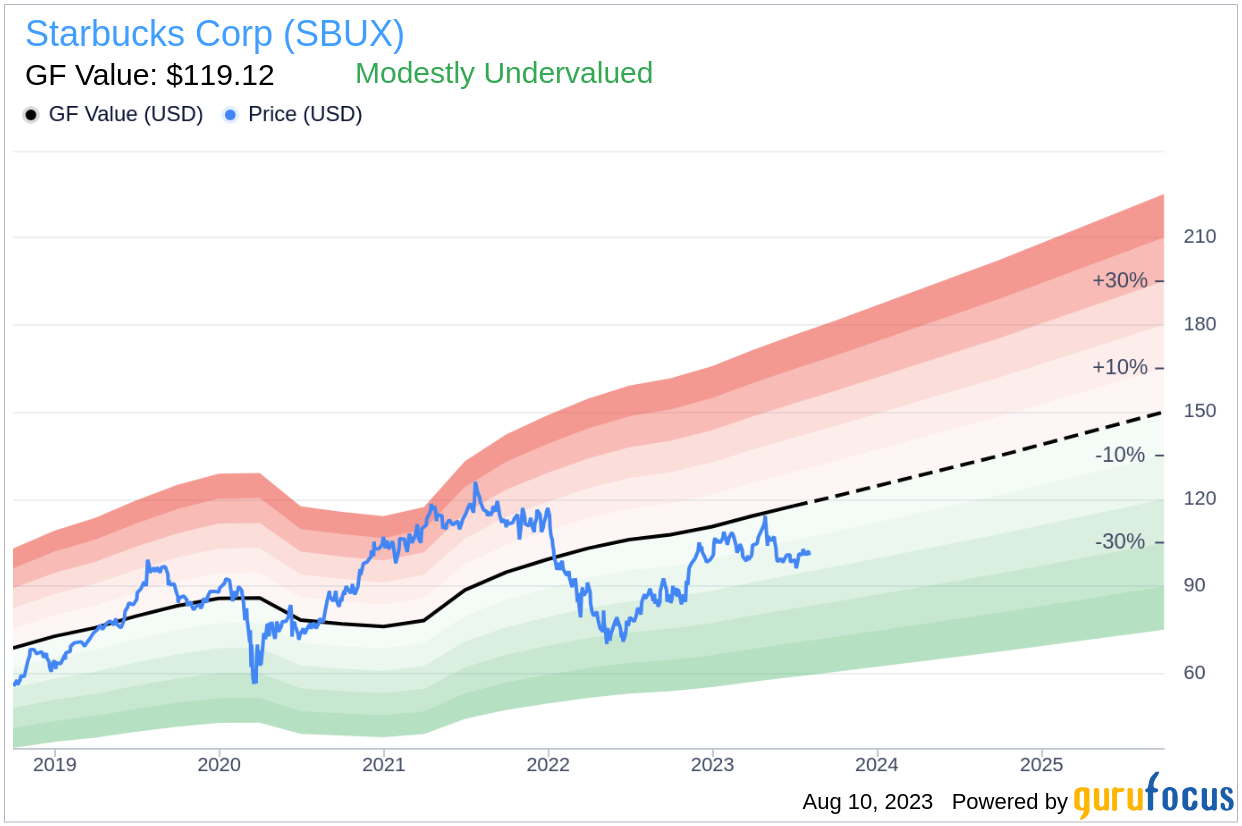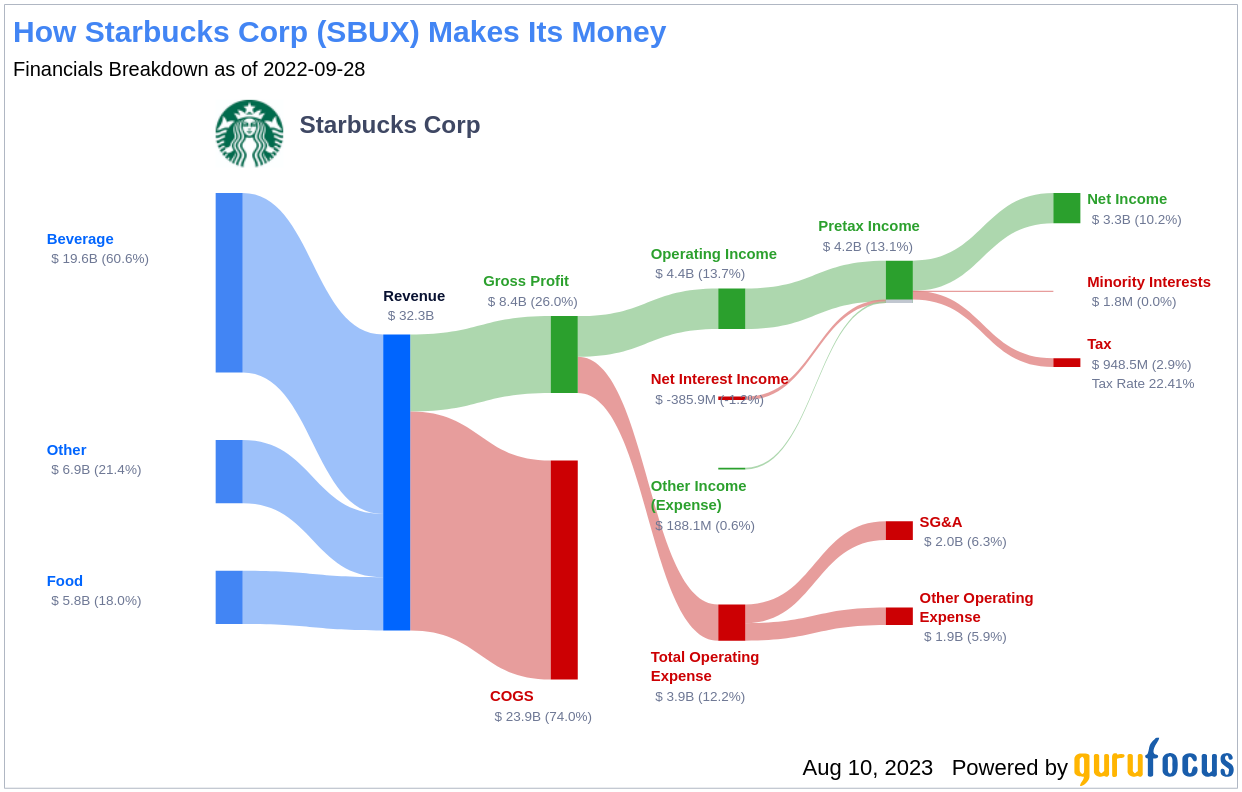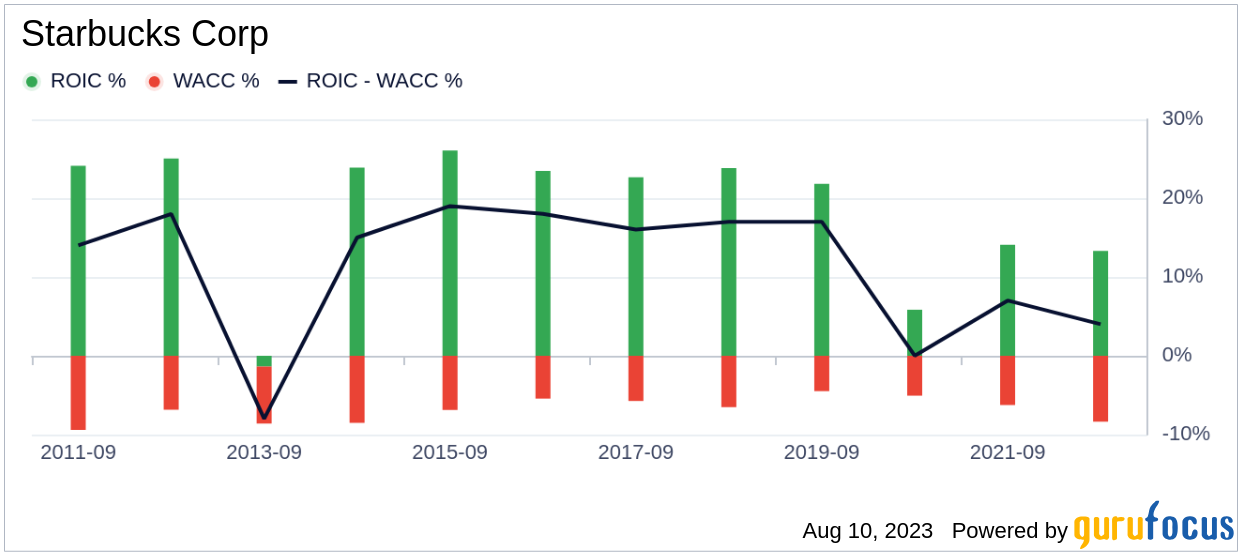Starbucks Corp (SBUX, Financial) has seen a daily gain of 2.34% and an Earnings Per Share (EPS) (EPS) of 3.28. However, over the past three months, the stock has experienced a loss of -3.64%. This leads us to question: is Starbucks (SBUX) modestly undervalued? This article aims to provide a comprehensive analysis of Starbucks' valuation, financial strength, profitability, and growth. Keep reading to gain valuable insights into this popular stock.
A Snapshot of Starbucks Corp (SBUX, Financial)
Starbucks is a globally recognized restaurant brand, operating nearly 36,000 stores in over 80 countries as of the end of fiscal 2022. The company operates in three segments: North America, international markets, and channel development (grocery and ready-to-drink beverage). Starbucks generates revenue from company-operated stores, royalties, sales of equipment and products to license partners, ready-to-drink beverages, packaged coffee sales, and single-serve products.
The current stock price stands at $101.72, with a market cap of $116.50 billion. Our analysis suggests that the stock is modestly undervalued, with a GF Value of $119.12. The following income breakdown provides a clearer picture of Starbucks' financial status:
Understanding the GF Value of Starbucks
The GF Value is a proprietary measure that represents the intrinsic value of a stock. It is calculated based on three factors: historical multiples (PE Ratio, PS Ratio, PB Ratio, and Price-to-Free-Cash-Flow) that the stock has traded at, GuruFocus adjustment factor based on the company's past returns and growth, and future estimates of business performance. The GF Value Line on our summary page provides an overview of the fair value at which the stock should ideally be traded.
According to our valuation method, Starbucks (SBUX, Financial) is believed to be modestly undervalued. If the stock's share price is significantly above the GF Value Line, the stock may be overvalued and have poor future returns. Conversely, if the stock's share price is significantly below the GF Value Line, the stock may be undervalued and have high future returns. As Starbucks is currently undervalued, the long-term return of its stock is likely to be higher than its business growth.

Link: These companies may deliever higher future returns at reduced risk.
Assessing Starbucks' Financial Strength
Before investing in a company, it's crucial to evaluate its financial strength. Companies with poor financial strength pose a higher risk of permanent loss. The cash-to-debt ratio and interest coverage can provide valuable insights into a company's financial strength. Starbucks has a cash-to-debt ratio of 0.15, which is worse than 72.44% of companies in the Restaurants industry. The company's overall financial strength is rated 5 out of 10, indicating fair financial health.
Here is a visualization of Starbucks' debt and cash over the past years:
Profitability and Growth of Starbucks
Investing in profitable companies is typically less risky, especially those that have demonstrated consistent profitability over the long term. Starbucks has been profitable 10 over the past 10 years. Over the past twelve months, the company had a revenue of $35 billion and an Earnings Per Share (EPS) (EPS) of $3.28. Its operating margin is 14.44%, which ranks better than 90% of companies in the Restaurants industry. Overall, GuruFocus ranks Starbucks' profitability at 9 out of 10, indicating strong profitability.
Growth is a critical factor in the valuation of a company. If a company's business is growing, it usually creates value for its shareholders, especially if the growth is profitable. Conversely, if a company's revenue and earnings are declining, the value of the company will decrease. Starbucks's 3-year average revenue growth rate is better than 78.38% of companies in the Restaurants industry. However, its 3-year average EBITDA growth rate is 2.1%, which ranks worse than 51.25% of companies in the Restaurants industry.
ROIC Vs WACC
Another method of determining the profitability of a company is to compare its return on invested capital (ROIC) to the weighted average cost of capital (WACC). The ROIC measures how well a company generates cash flow relative to the capital it has invested in its business. The WACC is the rate that a company is expected to pay on average to all its security holders to finance its assets. When the ROIC is higher than the WACC, it implies the company is creating value for shareholders. For the past 12 months, Starbucks's ROIC is 14.79, and its WACC is 8.49.
The historical ROIC vs WACC comparison of Starbucks is shown below:
Conclusion
In summary, the stock of Starbucks (SBUX, Financial) is believed to be modestly undervalued. The company's financial condition is fair, and its profitability is strong. However, its growth ranks worse than 51.25% of companies in the Restaurants industry. To learn more about Starbucks stock, you can check out its 30-Year Financials here.
To find out the high-quality companies that may deliver above-average returns, please check out GuruFocus High Quality Low Capex Screener.



